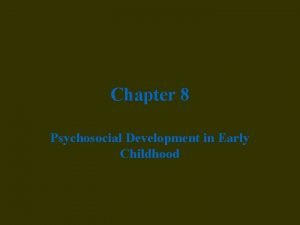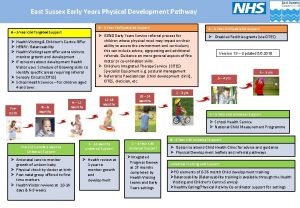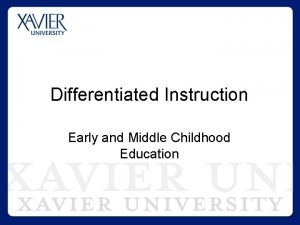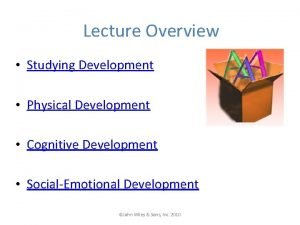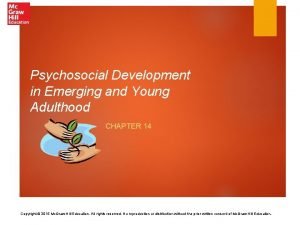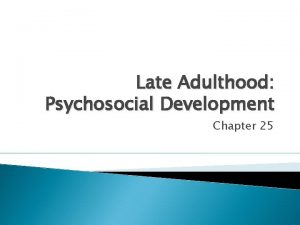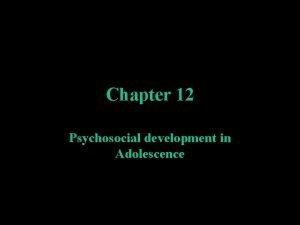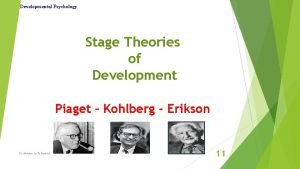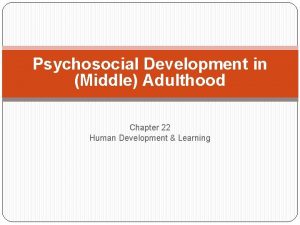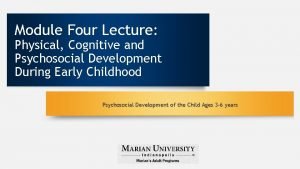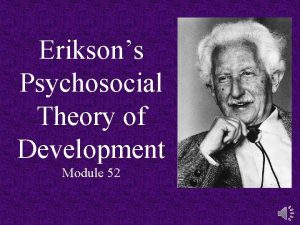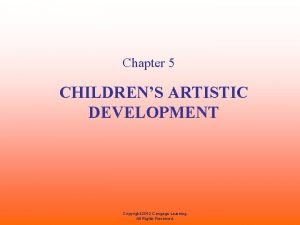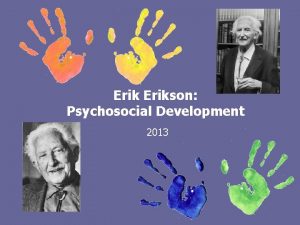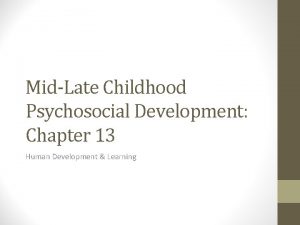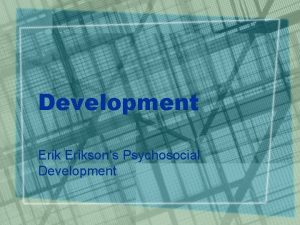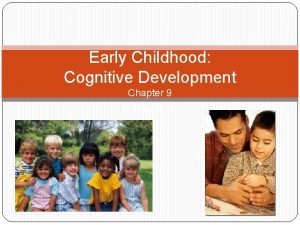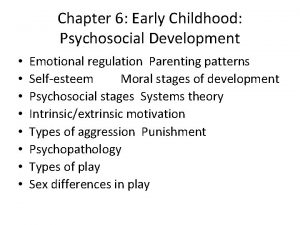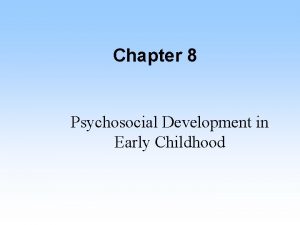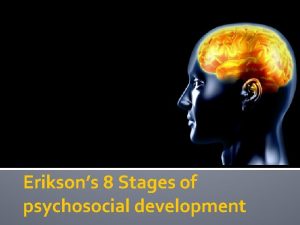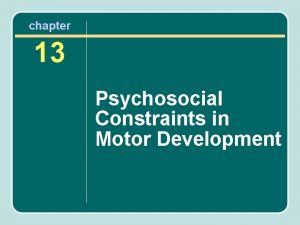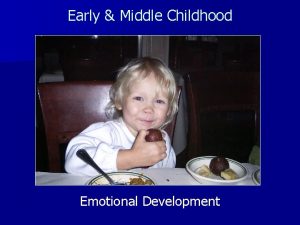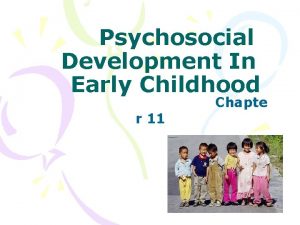Chapter 10 Early Childhood Psychosocial Development Human Development











































- Slides: 43

Chapter 10: Early Childhood Psychosocial Development Human Development & Learning

Hail Mary, full of grace! The Lord is with thee; blessed art thou among women, and blessed is the fruit of thy womb, Jesus. Holy Mary, Mother of God, pray for us sinners now and at the hour of our death. Amen.

Erikson’s Psychosocial Crises Age Crisis I (0 -1) trust vs mistrust II (2 -3) -toddler III (3 -6) preschool autonomy vs shame and doubt initiative vs guilt Relations Themes Virtue Malignancies mother to get, to give in return HOPE sensory maladjustment -withdrawal parents to hold on, to let go WILL impulsivity -compulsion family to play, to go after PURPOSE ruthlessness— (courage) inhibition

Building on previous crises: Hope Trust that has not been put to the test is fragile, unresilient. Unchallenged mistrust leads to withdrawal. Hope is certain, resilient, it persists even when it is unfulfilled.

HOPE The person who is certain that no letter has come has no reason to check the mailbox. The person who is certain that a letter has come won’t check again if no letter is there. The person with Hope will keep checking. Hope draws us into the future.

WILL The Self untempered by shame and (self)doubt is impulsive. The Self that is paralyzed by shame and (self)doubt is compulsive. WILL is a capacity to act towards an end.

PURPOSE/COURAGE Initiative vs. Guilt Notice: Shame vs. Guilt Initiative untempered by guilt results in Ruthlessness. Initiative paralyzed by guilt results in Inhibition. Purpose/ Courage: the capacity for action despite a clear understanding of your limitations and past failings.


Pride Young children generally have a very positive selfconcept and self-esteem. They overestimate their abilities. Every preschooler believes he/she is the brightest, smartest, fastest, most liked, best at games, etc.

Intrinsic Motivation Intrinsic motivation comes from within the individual; it is the joy of personal accomplishment. Adults can encourage this by not promising rewards for a task that is already enjoyable; instead, praise a job well done.

Emotional Regulation Emotional regulation is learning to cope with and direct one’s emotions. It develops as a result of brain maturation and experiences.

Emotional Intelligence involves learning how to interpret and express emotions. As the prefrontal cortex develops, children’s ability to regulate emotions improves. Caregivers intelligence. also play a role in teaching emotional

Externalizing and Internalizing Problems Externalizing problems occur when a child turns emotional distress outward (e. g. , attacking others in anger). Internalizing problems occur when a child turns emotional distress inward (e. g. , becoming anxious or withdrawn).

Gender Differences Boys are more likely to display externalizing problems. Girls are more likely to display internalizing problems.

The Importance of Play It is natural and beneficial for young children to PLAY! Jean Piaget said “Play is the work of the child. ” Children LEARN through play (and also relieve stress).

Who do they play with? Children prefer to play with: Peers Playmates of same sex

Types of Play Solitary = play alone Onlooker Parallel = watch others = play with similar toys in similar ways, but don’t interact Associative = interact and share emotions, but not in same game (e. g. , outdoor play)

Types of Play (cont. ) Cooperative = play together, with common goal, taking turns (e. g. , Checkers) Rough and tumble = mimics aggression, but is in fun (“play face”) It usually requires social experience among participants, and enough physical space to play.

LAURA DWIGHT

Types of Play (cont. ) Sociodramatic Play = Pretend play in which children act out self-created roles and themes Examples?

Sociodramatic Play Sociodramatic play helps children: Explore and rehearse social roles they have observed (e. g. , playing the “Dad”) Regulate emotions through imagination (e. g. , the powerful feeling of being a superhero) Learn to negotiate and cooperate with others

FELICIA MARTINEZ / PHOTOEDIT, INC.

Parenting Styles Diana Baumrind found that parents differ on four dimensions of parenting: Expressions Strategies Quality of warmth for discipline of communication Expectations for maturity


Outcomes of Parenting Styles Which parenting style would you guess is associated with the following outcomes? Children are obedient, not happy Children lack self-control, are not happy Children are successful, articulate, intelligent, and happy

Outcomes of Parenting Styles Authoritarian: Children are obedient, not especially happy Permissive: Children lack self-control, are the least happy Authoritative: Children are successful, articulate, intelligent, and happy


Moral Development The development of a sense of what is wrong and right. The development of the ability to act in according with this understanding.

Empathy and Antipathy Empathy: a true understanding of the feelings and concerns of another This results in prosocial behavior (e. g. , helpful, kind) and is helped by theory of mind. Antipathy: Results a dislike or hatred of people in antisocial behavior (e. g. , aggressive).

Aggression All children experience the emotion of anger, but aggression involves hostile attitudes and hurtful, destructive behavior towards others. Some types of aggression are more troublesome and long-lasting than others (see next slide).

Types of Aggression Instrumental: Used to obtain an object such as a toy This is common among young children, and becomes less prevalent with age. Reactive: Retaliation for an act, whether or not it was intentional This indicates a lack of emotional regulation.

Types of Aggression (cont. ) Relational: Insults or social rejection intended to hurt another Example: Bullying: “You can’t come to my party. ” Unprovoked, repeated attack to inflict physical or mental harm

Parental Discipline Physical punishment (aka “corporal punishment”) Psychological control Exclusion and conversation Time-out Induction

Genderization Sex differences = biological differences between males and females Gender differences = culturally imposed differences in the roles and behaviors of males and females Is this a good definition of gender?

Gender Awareness By age 2 cognitive awareness of gender; gender-related preferences and play patterns are apparent By age 3 rudimentary awareness that gender distinctions are lifelong By age 4 awareness of “gender-appropriate” toys and roles age 6 well-formed ideas and prejudices about own and other sex

Theories of Gender Differences Psychoanalytic Phallic Oedipal Theory (Freud) stage = third stage of psychosexual development complex Identification Superego

Behaviorist Theory of Gender roles are learned through observation and imitation. Examples: Who takes out the garbage? Who cooks? RONNIE KAUFMAN / CORBIS

Cognitive Theory of Gender schemas organize the world into “male” and “female” activities. This is guided by an internal motivation to conform to sociocultural standards of gender. Example: “Is this a (boy/girl) thing to do? ”

Sociocultural Theory of Gender Children learn the preferred behavior for men and women in their society. Androgyny = a healthy balance of male and female psychological characteristics What does this actually mean?

What is healthy Androgyny? Some people interpret findings that “psychologically androgyny” is associated with psychological well-being as a case against gender complementarity, but I think this is inaccurate. Real, healthy people are not caricatures or exaggerations of gender stereotypes and to make this the case, in reality or in fantasy, reduces a person to some part. Real people are full , complex, and well-rounded, not walking gender stereotypes.

For example, check out this over-”feminized, ” glamorized depiction of our Blessed Mother. She is pretty, but as Dr. M. Waldstein would say, “dripping with saccharin. ” Does this image really capture the deep beauty of the feminine mystery?

Socialized Gender? Some of the things that we think of as being feminine and/or masculine arise directly from differences in our physical bodies. The fact that women and men walk differently, for example, has more to do with anatomical difference in center of gravity, hip-structure, etc. And variations in voice pitch (i. e. , higher “feminine, ” lower “masculine) reflect hormonal differences. These things can be imitated, enhanced, or overridden to some extent —there is also individual variation- but we cannot reduce them to social constructs.

Epigenetic systems theory Gender typed behavior is shaped by BOTH genetic differences between male and female brains and bodies, and environmental influences. That is, our experiences shape our behavior, our bodies shape our behaviors, our bodies alter our experiences, our experiences and behaviors alter our bodies and brains, expectations about our behaviors, brains, bodies and experiences shape our brains, behaviors, bodies and experiences, and every other confusing, entangled combination of any of these things you can think of is also happening. If you didn’t read that in a superfast voice, you should do so now to get a fuller effect of what I am trying to convey.
 Psychosocial development in early childhood
Psychosocial development in early childhood Principles of growth and development
Principles of growth and development Emotional changes in adulthood
Emotional changes in adulthood A vygotskian classroom promotes ________.
A vygotskian classroom promotes ________. Fine motor skills development in early childhood
Fine motor skills development in early childhood Physical development in early childhood
Physical development in early childhood Language development in early childhood
Language development in early childhood What is biosocial development in early childhood
What is biosocial development in early childhood Ldoe delivery recipes
Ldoe delivery recipes Cognitive development in childhood
Cognitive development in childhood Types of early childhood programs chapter 2
Types of early childhood programs chapter 2 Chapter 7 early childhood ages 3 through 5 answer key
Chapter 7 early childhood ages 3 through 5 answer key Psychosocial stages
Psychosocial stages Chapter 7 human growth and development
Chapter 7 human growth and development Psychosocial development in young adulthood
Psychosocial development in young adulthood Late adulthood psychosocial development
Late adulthood psychosocial development Trust vs mistrust stage
Trust vs mistrust stage Intiative vs guilt
Intiative vs guilt Psychosocial development in adolescence
Psychosocial development in adolescence Erickson's psychosocial theory of development
Erickson's psychosocial theory of development Erikson's psychosocial theory of development
Erikson's psychosocial theory of development Middle adulthood psychosocial development
Middle adulthood psychosocial development Define physical cognitive and psychosocial development
Define physical cognitive and psychosocial development Erik erikson theory
Erik erikson theory Chapter 10 geriatric care
Chapter 10 geriatric care Chapter 8 human needs and human development
Chapter 8 human needs and human development Chapter 8 human needs and human development
Chapter 8 human needs and human development Types of early childhood programs
Types of early childhood programs Efq examples of practice
Efq examples of practice Efq
Efq Pdp early childhood education and training program
Pdp early childhood education and training program How to welcome parents in orientation
How to welcome parents in orientation Acecqa self assessment tool
Acecqa self assessment tool Leonardo da vinci early childhood
Leonardo da vinci early childhood Trends in early childhood education
Trends in early childhood education Early childhood research quarterly author guidelines
Early childhood research quarterly author guidelines Early childhood ireland garda vetting
Early childhood ireland garda vetting Kellogg's stages of artistic development
Kellogg's stages of artistic development Amelia earhart facts about her childhood
Amelia earhart facts about her childhood Prosposed
Prosposed Pedagogical leadership skills
Pedagogical leadership skills Isaac newton early childhood
Isaac newton early childhood Eminem early childhood
Eminem early childhood Early childhood education in pakistan
Early childhood education in pakistan
